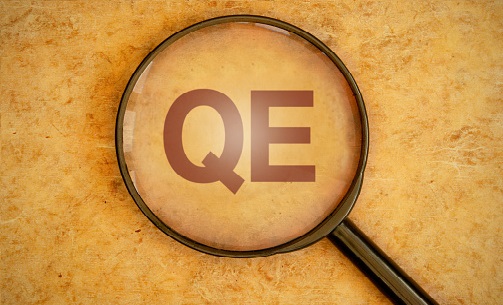Risk appetite is starting the new week on a firmer footing this morning; major Asian equity bourses enjoyed decent gains overnight (Shanghai Comp +1.5%, Hang Seng +1.1%, Nikkei 225 +1.8%) and this is helping to push US and European equities higher; with regards to the former, E-mini S&P 500 futures are up about 0.3% on the session and back around the 4450 mark, continuing the rebound from last Thursday’s lows which saw the index drop as low as the 4350 mark. Meanwhile, the Stoxx 600 is up about half a percent this morning and is back above 470, having been as low as 463 last Wednesday. Some have cited the fact that China reported zero new Covid-19 infections on Monday as a positive, but the macro picture isn’t that much changed from where things were left off at the end of last week; ex-China, the tone of global Covid-19 related news remains negative, with worries rising now about waning vaccine efficacy after three months and the implications this might have for the recovery. As a result, market commentators are calling this morning’s rebound “technical” (i.e. driven by profit taking, for example).
Many suspect that markets will remain cautious for the rest of the week ahead of remarks from FOMC Chairman Jerome Powell on Friday at the (now being held online) Jackson Hole central bank symposium. For reference, the Fed had recently been playing down the impact they suspect the spread of the delta variant is going to have on the economy, but financial press was getting excited about some comments from one of the more hawkish FOMC members Kaplan last Friday, who noted that the spread of the delta variant might force him to adjust his economic forecasts. Some analysts have also suggested that the Fed’s decision last Friday to move the Jackson Hole event online (they cited public health risks amid the virus outbreak) might also be indicative of their growing caution about how the health situation might impact the economy.
Back to markets this morning; it’s not just stocks recovering on Monday. Commodities that got hammered last week are firmly on the front foot, with front-month WTI futures up roughly 3.0% on the session, Copper up 2.0% and various international iron ore benchmarks also gaining. This is giving a helping hand to the more commodity sensitive G10 currencies such as NOK, CAD, AUD and NZD; USDCAD is 0.7% lower and back under the 1.2750 mark, having nearly been above 1.30 last week. AUDUSD (up 0.6% on the day) is trying to recover back towards 0.7200 and NZDUSD (also up 0.6% on the day) has recovered to the north of the 0.6850 mark. However, the Covid-19 situation in Australia and New Zealand remains fragile; health authorities in Australia reported a record number of new infections on Monday as the state premier of Victoria expanded the Melbourne lockdown to the rest of the state (to begin from Saturday), while in New Zealand, a further 35 infections were reported, and PM Ardern announced that the whole country will remain in level four lockdown alert until Friday and Auckland in lockdown until the end of the month. Given the deteriorating situation in both countries, which has the ability to simultaneously damage the pace of their economic recoveries as well as throw off plans by monetary policy makers for policy normalisation, traders suspect that rallies in AUD and NZD remain vulnerable to being sold. A more protracted pick up in global sentiment and signs that the domestic Covid-19 outbreaks are being brought under control will likely be needed for AUDUSD and NZDUSD to see more sustained recoveries.
Elsewhere, safe haven assets are the underperformers this morning amid the improved appetite for risk; the US dollar, Japanese yen and Swiss Franc are the worst there performing currencies in the G10, with the DXY having fallen back below the 93.50 mark and testing support in the form of the July 21st and August 11th double top around 93.20. USDCHF is flat at just above 0.9150 and USDJPY is about 0.3% higher and to the north of the 110.00 level. The US dollar is failing to derive any support from a rise in US bond yields; 10-year yields are up 2bps to 1.275% this morning, weighed also by their safe haven status. Yields in Europe are also for the most part higher (German 10-year yields are 3bps higher at about -0.47%).
Elsewhere in FX markets, EURUSD and GBPUSD are both enjoying modest rebounds as a result of dollar weakness more so than anything else, with the former now comfortably back to the north of the 1.1700 level and the latter staging a rebound from the low 1.3600s to the 1.3675 area. Eurozone and UK preliminary PMI surveys for the month of August were released this morning and didn’t provoke much of an FX nor broader market reaction; for reference, Eurozone PMIs were broadly a little softer than expected, but still at very healthy levels (manufacturing came in at 61.5 and services at 59.7), while in the UK the size of the drop in services PMI from the month prior (to 55.5 from 59.6) was somewhat alarming and shows the impact that the increased rate of spread of the delta variant in the country, as well as the “pingdemic” (where hundreds of thousands of people were being told to self-isolate by the NHS app). This data will feed into the “growth slowdown” narrative that weighed on risk appetite last week. Price pressures were also seen as still elevated in August, according to the PMIs, though inflation in Europe remains less of a concern for markets right now.
The Day & Week Ahead
The main event of today will be the release of the preliminary US Markit PMI surveys for the month of August which will inform narratives around the alleged slowing of the pace of US economic growth as Q3 progresses. This data will be out at 1445BST. US Existing Home Sales data for the month of July is then out at 1500BST might also be worth a watch, but markets will likely be paying closer attention to August Eurozone Consumer Confidence numbers, out at the same time after this morning’s PMIs. Otherwise, things are likely to be quiet for the rest of the session and likely for the rest of the week, with global Covid-19 news set to be the main driver ahead of the Jackson Hole event, which begins on Thursday, but the highlight of which is an address from Fed Chair Powell on Friday. US Core PCE data for July (the Fed’s favoured inflation gauge) is also out on Friday and adds to the reasons why markets are likely to remain cautious ahead of the final day of the week.




